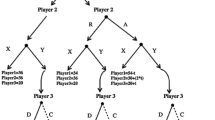Abstract
This paper analyzes the reputation-based incentives of a Self-Regulatory Organization (SRO) to detect and expose consumer fraud committed by its members, and the members’ incentives to bribe the SRO in exchange for a cover-up to avoid an external punishment. In a corruption-free benchmark, SROs are effective in detecting, exposing and deterring fraud only if exposure yields a reputation gain to the SRO, which depends on consumers inferences about the SRO’s type. However, if this case prevails the member can succeed in bribing the SRO in exchange for a cover-up and impunity. Despite this, a bribed SRO yields more vigilance and lower fraud than no self-regulation at all.
Similar content being viewed by others
References
Bortolotti, B., & Fiorentini, G. (1999). Barriers to entry and the self-regulating professions: Evidence from the market of Italian accountants. In Organized interests and self-regulation; an economic approach (pp. 131–157). Oxford: Oxford University Press.
Cho I.-K., Kreps D. (1987). Signalling games and stable equilibria. Quarterly Journal of Economics 102, 179–222
Emons W. (1997). Credence goods and fraudulent experts. RAND Journal of Economics 28(1): 107–119
Fudenberg D., Tirole J. (1991). Game Theory. MIT Press, Cambridge, Mass
Gehrig T., Jost P.-J. (1995). Quacks, lemons, and self regulation: A welfare analysis. Journal of Regulatory Economics 7, 309–325
Harsanyi, J. (1982). Morality and the theory of rational behaviour. In A. Sen & B. Williams (Eds.), Utilitarianism and beyond. Cambridge: Cambridge University Press.
Laffont J.J., Tirole J. (1991). The politics of government decision-making: A theory of regulatory capture. Quarterly Journal of Economics 106(4): 1089–1127
Maxwell J., Lyon T., Hackett S. (2000). Self-regulation and social welfare: The political economy of corporate environmentalism. Journal of Law and Economics 43(2): 583–617
Milgrom P. (1981). Good news and bad news: Representation theorems and applications. Bell Journal of Economics 12, 380–391
Milgrom P., Roberts J. (1986). Price and advertising signals of product quality. Journal of Political Economy 94, 796–821
Nunez J. (2001). A model of self regulation. Economics Letters 74, 91–97
Pirrong S. (1995). The self-regulation of commodity exchanges: The case of market manipulation. Journal of Law and Economics 38, 141–206
Polinsky A.M., Shavell S. (2001). Corruption and optimal law enforcement. Journal of Public Economics 81, 1–24
Scarpa C. (1999). The theory of quality regulation and self-regulation: Towards an application to financial markets. In: Bortolotti B., Fiorentini G. (eds). Organized interest and self-regulation. Oxford University Press, Oxford, pp. 236–260
Shaked A., Sutton J. (1981). The self-regulating profession. Review of Economic Studies 48, 217–234
Shapiro C. (1982). Consumer information, product quality and seller reputation. Bell Journal of Economics 13, 20–35
Stefanadis C. (2003). Self-regulation, innovation, and the financial industry. Journal of Regulatory Economics 23(1): 5–26
Tirole J. (1996). A theory of collective reputations with applications to the persistence of corruption and to quality. Review of Economic Studies 63(1): 1–22
Van den Bergh R. (1999). Self regulation of the medical and legal professions: Remaining barriers to competition and EC law. In: Bortolotti B., Fiorentini G. (eds). Organized interest and self-regulation. Oxford University Press, Oxford, pp. 89–130
Author information
Authors and Affiliations
Corresponding author
Rights and permissions
About this article
Cite this article
Núñez, J. Can self regulation work?: a story of corruption, impunity and cover-up. J Regul Econ 31, 209–233 (2007). https://doi.org/10.1007/s11149-006-9020-x
Published:
Issue Date:
DOI: https://doi.org/10.1007/s11149-006-9020-x




